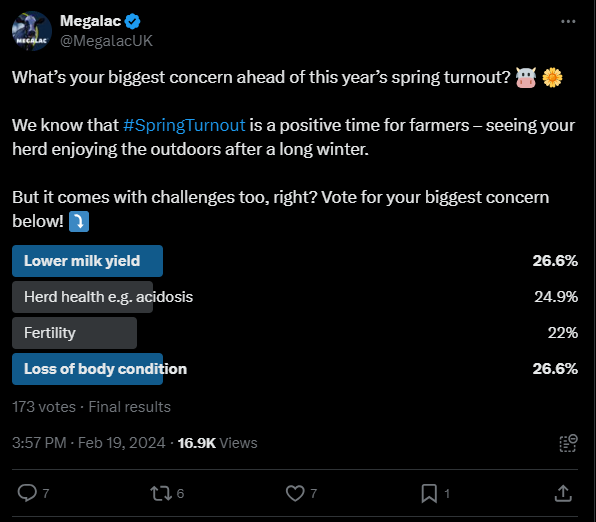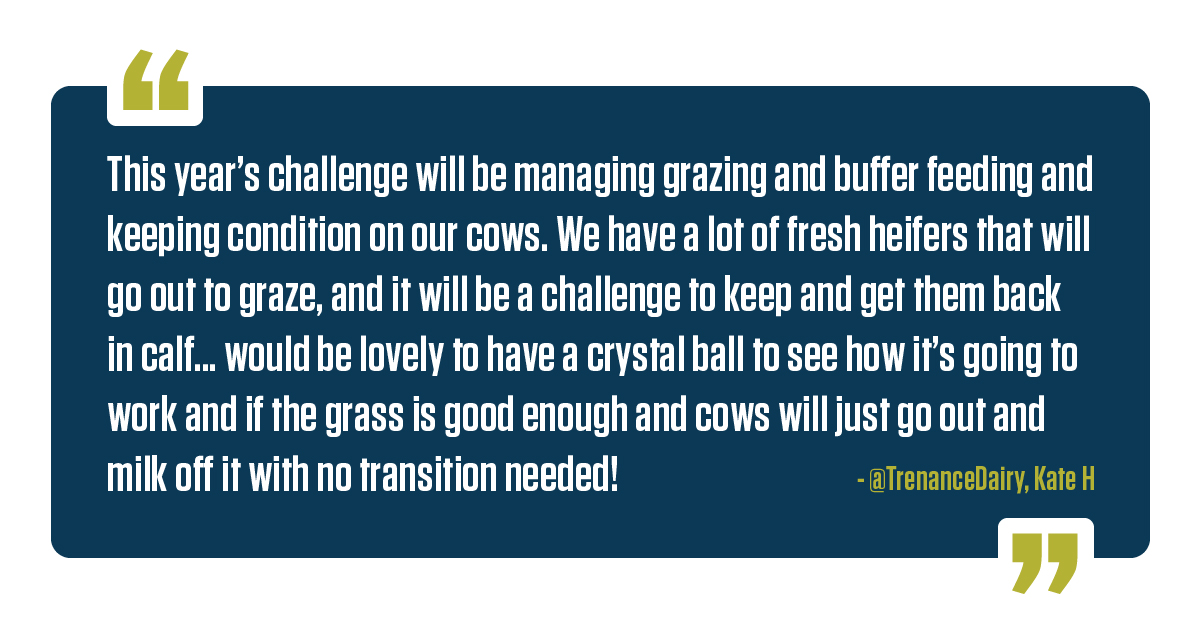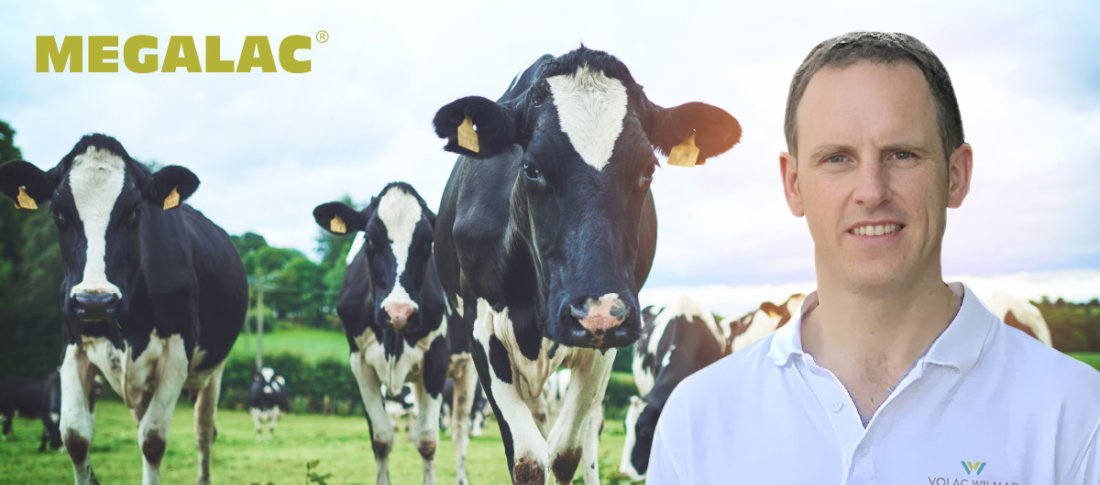Preparing your dairy herd for spring can be a tricky task – keeping one eye on your cows’ health and one eye on the weather. Especially when it’s been as wet as it has in the UK and Ireland over the last few months.
We reached out to you, the farming community, to ask what your top concerns are around turnout this year and then spoke to our resident nutrition expert, Dr Richard Kirkland, to get his insights.

Your poll responses show that your main concerns are quite evenly split between milk yield, herd health and body condition (with fertility not far behind).
Cornish farmer, Kate Hoare of Trenance Dairy, told us that as well as dealing with wet weather, fertility and body condition are front of mind for her:
 Some of you also commented that managing ground/grass conditions is particularly tough this year, thanks to all the rain. Rotating fields, monitoring sward length and applying fertiliser can all be useful.
Some of you also commented that managing ground/grass conditions is particularly tough this year, thanks to all the rain. Rotating fields, monitoring sward length and applying fertiliser can all be useful.
How can farmers avoid acidosis and maintain milk yields once their cows are on grass?
Dr Richard says: Supplementing grass with concentrates provides additional energy that will help your cows maintain milk production. But take care with what supplements you choose, as excessive starch risks increasing acid load in the rumen and a fall in milk fat percentage.
Rumen-protected fats provide a concentrated source of energy without adding to the acid load in the rumen, and formulations with higher levels of palmitic acid (C16:0) specifically stimulate milk fat production.
Grass intake will vary daily due to growth conditions, weather, and other factors, so supplements will help you ensure that cows eat sufficient energy to meet their milk production potential - even when intake is reduced.
Why is butterfat depression common at spring turnout and what’s the best way to mitigate it?
Dr Richard says: Early spring grass has a low fibre content, resulting in minimal ‘scratch factor’ and causing low stimulation of saliva for buffering of acid in the cow’s rumen. It also has high sugars, which makes it rapidly fermentable in the rumen, leading to higher acid, reduced rumen pH and a degree of acidosis. Coupled with a high ‘free’ oil concentration, these are conditions which can lead to significantly reduced milk fat.
Helping to slow the rate of passage through the rumen by adding fibre sources helps reduce these negative effects and improve grass utilisation and digestion. Digestible fibre sources like soya hulls and citrus pulp provide a higher level of energy than bulky fibre sources such as straw.
Rumen-protected fat supplements (such as Megalac) provide a concentrated source of energy without adding to the acid load in the rumen, and formulations with higher levels of palmitic acid (C16:0) specifically help stimulate milk fat production.
In this respect, Mega-Fat 70 would be a good option at this stage where milk fat is a concern, as it provides a higher level of milk fat-boosting palmitic acid, and a rumen-protected source of oleic acid (C18:1) to aid fertility and body condition. The typical ‘high-C16’ supplements like Mega-Fat 88 provide the highest levels of milk fat-boosting C16:0, but care needs to be taken as these supplements can lead to excessive body weight loss with negative impacts on cow health and fertility.
How and why can spring turnout affect fertility? What can be done about it?
Dr Richard says: Spring turnout to grass is a major dietary change from the indoor rations over winter. Additionally, a cow’s ability to consume adequate grass can vary from day to day and with weather conditions and availability, which heightens the risk of inadequate energy intake to meet requirements, leading to loss of body condition as they ‘milk off their backs’ to provide the energy to support milk production.
Supplements help ensure sufficient energy is consumed by the cow to meet demands for milk production and reduce body condition loss. Research from the University of Nottingham indicates that conception rate falls by about 10% per 0.5 unit loss in body condition score through early lactation. Ensuring high energy intake is a key. Rumen-protected fats provide a concentrated source of energy without adding to the acid load in the rumen, so are a very ‘safe’ form of energy.
Additional fat also improves progesterone production – the key hormone of pregnancy – and the calcium salt formulations like Megalac, Mega-Max and Mega-Fat 70 provide oleic acid, which stimulates egg development, improves body condition score, and improves total dietary fat digestion to provide additional energy from the basal diet.
Why do some cows lose body condition at turnout? What do you advise?
Dr Richard says: Body condition loss primarily reflects loss of body fat. Cows produce milk and have genetic drive to do so, but if they can’t consume sufficient feed to meet the energy requirements for that milk, they will ‘milk off their backs’ as body fat stores are released and used to supply energy to make up the energy shortfall.
If a cow consumes more energy (e.g. if you boost intake with highly-energy dense fat supplements), then they use less of their body fat to support milk production and, therefore, target reduced body condition loss.
Products like Megalac, Mega-Max and Mega-Fat 70 help support body condition as the C18:1 component influences insulin status and helps reduce body tissue loss, whereas ‘high-C16’ supplements can exacerbate tissue fat loss. If you’re unsure about specific needs of your cows we can advise you on which supplements to offer during the various stages of lactation.
So there you have it: our resident nutritionist’s suggestions for managing spring turnout this year.
And while we can’t provide you with the “crystal ball” that farmer Kate Hoare wished for, hopefully these insights will help equip you to tackle spring turnout with confidence.
Get more spring turnout advice from Dr Richard Kirkland by searching our blog.
